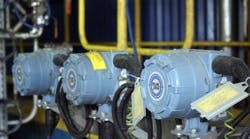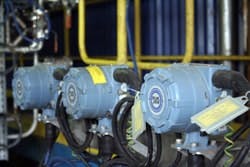Polymer Plant Achieves Record Output
Nothing could be more gratifying for plant personnel than helping output grow well beyond original design capacity — especially when product demand is strong. This is exactly what’s happened at Synthomer’s synthetic polymers plant in Kluang, Malaysia: in just three years reactor output has risen by more than 30% over nameplate rating.
The plant achieved this performance despite frequent alterations for product upgrades to meet competitive pressures. In addition, it still had to precisely follow batch formulas to match customer specifications or entire batches might have to be scrapped. Synthomer was able to establish its output record in large part because of shorter turnaround times between batches and batch-to-batch repeatability that’s more than 30% better than expected. We also have gained from substantial reductions in non-conforming and aborted batches.
[pullquote]Among the original design goals for the plant, which was commissioned in 2002, were high process reliability in responding to customer needs, flexibility, product consistency and batch traceability through accurate documentation. The plant couldn’t have attained any of these goals without Synthomer’s commitment to an advanced control system architecture, a batch-friendly automation system, smart field instrumentation and device management software capable of utilizing the intelligent devices’ self-diagnostics. It’s a small plant but our instrumentation is highly sophisticated.
Sophisticated Batch Control
The Kluang plant produces synthetic emulsion polymers, which are substitutes for natural latex and other products, used for surgical gloves or as additives in making cement, carpets, fabrics, etc. Petroleum derivatives such as butadiene and acrylonitrile serve as raw materials, so the plant is classified as a Zone 1 hazardous area.
The slightest process variability could affect the complex reactions of multiple components, leading to substandard and unacceptable final product. Because manual intervention causes inconsistencies, operators’ interactions with the reactors had to be minimized. The project designers knew advanced technology systems were essential to provide the necessary fully automated and highly sophisticated batch and recipe control.
After reviewing several alternatives, we chose to implement Foundation Fieldbus using Emerson’s PlantWeb digital plant architecture. This approach integrates all intelligent field devices, including digital valve controllers, transmitters and converters from various vendors, providing a fast, sure way of digitally communicating control input/output (I/O). In addition, it enables easy future integration of machinery health monitoring. The architecture greatly reduced the amount of field wiring required, thereby lowering construction time and costs.
We considered the DeltaV digital automation system to be the most “batch friendly.” It’s a system designed to do batch processing in reliable controllers, not one for continuous processing with batch software added as an afterthought. We also deemed it to have greater flexibility and better adaptability to changes and to be easiest to expand in the future.
With the batch schedules embedded and integrated into the DeltaV system, operators simply load a recipe, press “Start” and the process runs automatically until the batch is finished. Individuals only are involved in handling raw materials and finished products. They don’t interfere while a batch is in progress.
The flexibility of this automation system allows Synthomer engineers to easily accommodate process changes and even institute improvements between batches if necessary. Everything begins with reliable digital data received from fieldbus devices. The reactor instrumentation includes magnetic flow transmitters, vortex flow transmitters, pressure and temperature transmitters, mass flow meters, fieldbus-to-current converters, radar level transmitters, multivariable temperature transmitters and digital valve controllers. These smart devices, made by a variety of vendors, transmit highly accurate readings that enable faster response by automated controls.
The fieldbus instruments also generate useful diagnostic data on their own condition and that of the process, aiding in the troubleshooting of suspected problems in two ways:
1. Operators quickly recognize if a given device is OK — no one has to go to check it out;
2. Any problem that exists is immediately pinpointed — so the maintenance technician can be told exactly what to look for and what tools and supplies to take.
The field-generated information allows us to optimize the control system over time to improve jacket heat-up time. We now can reach the temperature set point faster so the batch gets started sooner. This has reduced dead time for recharging a reactor, even when switching products to satisfy an order.
Quality remains consistently high due to excellent batch-to-batch reproducibility with the DeltaV system. Reliable data from the fieldbus instrumentation have resulted in better flow control, affording more accurate batch charge quantities. Improved reactor temperature control further contributes to consistency. In addition, we can make changes in-house to phase logic and equipment modules for greater reliability and reproducibility across reactors.
No one wants to abort an expensive batch but if control is lost due to excessive deviation from the ideal temperature profile such action may be inevitable. Improved temperature control — a direct result of digital temperature measurement and transmission — reduces this problem. Better flow control stemming from improved instrumentation leads to more accurate additions to the reactor and quicker reactions, further decreasing the probability of an aborted batch because of inaccurate addition of ingredients.
Data from the fieldbus devices also are used in report generation, instilling confidence in managers making operational decisions.
Preempting Problems
Another beneficial technology employed from the beginning is Emerson’s AMS Suite: Intelligent Device Manager, which seamlessly integrates with the DeltaV system. This predictive maintenance software works in concert with PlantWeb architecture and fieldbus communications protocol, capturing diagnostic data generated by fieldbus devices, maintaining a device database and raising alerts to potential problems.
AMS Device Manager is always on, capturing diagnostics and keeping operators and technicians continuously informed of potentially serious conditions.
We’ve received status alerts such as “reverse flow detected,” “low cut-off active,” valve “travel out of range,” and “device needs maintenance soon.” These alerts occur frequently on the reactors, our most critical process units. Each is fieldbus-intensive, with a number of flow meters (Figure 1) and control valves. Status alerts help keep us ahead of unforeseen issues, reducing the potential for “work-offs.”
The alerts instantly bring emerging concerns to the attention of plant personnel, enabling them to obtain detailed information from devices or valves. With knowledge of what’s happening on a real-time basis, staff normally can prevent unexpected upsets and implement predictive maintenance to extend the life of the field devices.
We can even access field-generated data from home simply by dialing in. We do it all the time, frequently avoiding a trip to the plant. The ability to check on the system and process in the evening helps us sleep better, too.
AMS Device Manager takes advantage of Electronic Device Description Language (EDDL) to monitor process variables, configure/setup a device, and diagnose that device. EDDL enables access to different device types (pressure, temperature, flow, etc.) from different manufacturers through a single software application.
AMS Device Manager has streamlined the commissioning of fieldbus devices. It allows querying those devices directly from one central location — workers in the plant don’t have to identify specific devices and verify device operation and loop integrity.
Because many of Synthomer’s products wind up in FDA-regulated medical goods, customers frequently audit the Kluang plant. They require easily accessible and accurate information about every batch as well as maintenance histories of field devices. The control system maintains the records needed for batch traceability while asset management software automatically records every contact with field devices and any changes made to their configuration, providing the necessary device documentation.
Challenges and Solutions
Because digital architecture was fairly new at the time and this was the first use of Foundation Fieldbus devices at our company, support for the project and long-term operation were concerns. Malaysia is a long way from home-base in the U.K., so we deliberately selected an easy-to-use system from a vendor that provides reliable local support. In addition, we arranged for:
• training on the DeltaV system and AMS Device Manager in Malaysia and Singapore. Process engineers, maintenance technicians, etc., attended task-oriented sessions to learn what they needed to know for their specific job functions;
• a commissioning engineer with Foundation Fieldbus experience; and
• getting in advance the right tools, including the 375 Field Communicator, which supports fieldbus and can do some bus diagnostics, as well. Our technicians are accustomed to working with a handheld communicator; it was a big comfort factor when it became necessary to work with devices in the field.
The contractor had no previous experience with fieldbus and received no special training in advance. An Emerson engineer was on-site for a week, supervising hardware installation; a Synthomer employee, Mike Gorsen, supervised the contractor. This partnership resulted in an exceptionally short period for installation and commissioning.
Payback
These technologies began to pay off almost immediately. We saved time and money during construction, and instrument commissioning was extremely successful. It only took eight days to commission, loop test and water test all field devices for our recent expansion instead of the 30 days set aside for these tasks. When the plant was started, everything functioned perfectly; the very first batch met specification. As a result, we’ve been able to provide the additional volume in this highly competitive market earlier than anyone expected.
Flexibility and ease-of-use of these technologies have enabled Synthomer to cut recipe development time by 15%, allowing for faster turnarounds to meet changing customer demands, to take advantage of raw material availability and pricing, and to capitalize on new business opportunities.
The most important financial benefit has come from achieving productivity beyond our expectations. After three years of operation, output had risen to 54,000 metric tons/year, a 30% increase over the plant’s design capacity of 40,000 metric tons/year.
PlantWeb architecture including AMS Device Manager with the DeltaV automation system made this possible. We relied on the same system for the most recent expansion, resulting in an increase to 130,000 metric tons/year by the end of 2008.
Adrian Moody is process technology manager for Synthomer Sdn. Bhd., Kluang, Malaysia. Ricky Bingham is project manager for Synthomer Sdn. Bhd., Kluang, Malaysia. E-mail them at [email protected] and [email protected].



